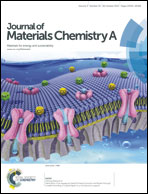Synthesis of Sn/MoS2/C composites as high-performance anodes for lithium-ion batteries
Abstract
Tin (Sn) has been considered as one of the most promising anode materials for high-performance lithium ion batteries (LIBs) due to its high theoretical capacity, abundance and low toxicity. However, fast capacity fading and poor rate capability hinder its application in LIBs. Herein, we report a novel composite consisting of few-layer MoS2 and Sn nanoparticles synthesized as an anode for LIBs. In such a composite anode, MoS2 nanosheets provide flexible substrates for the nanoparticle decoration, accommodating the volume changes of Sn during the cycling process, while Sn nanoparticles also can act as spacers to stabilize the composite structure and make the active surfaces of MoS2 nanosheets accessible for electrolyte penetration during the charge/discharge process. Electrochemical measurements demonstrated that the Sn/MoS2/C composite exhibits extremely long cycling stability even at high rate (a reversible capacity of 624.5 mA h g−1 at a current density of 1 A g−1 after 500 cycles) and superior rate capability (1050 mA h g−1 at 100 mA g−1, 895 mA h g−1 at 200 mA g−1, 800 mA h g−1 at 500 mA g−1, 732 mA h g−1 at 1 A g−1 and 630 mA h g−1 at 2 A g−1).


 Please wait while we load your content...
Please wait while we load your content...